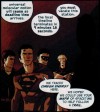-
Terminal World
- by Alastair Reynolds
- HC, Victor Gollancz (UK), © 2010, 487 pp, ISBN 978-0-575-07718-8
Did hard SF writer Alastair Reynolds construct Terminal World just so he could write a steampunk adventure? Since the world is filled with dirigibles, which as I recently observed is the flavor du jour of steampunk, it sure seems like it. But there’s a lot more in here, too.
The novel opens in Spearpoint, the last city on Earth, a giant tower jutting towards the sky, covered with several towns, each of which has a lower technology level as you get closer to the surface (the Celestial Levels, Circuit City, Neon Heights, Steamtown, Horsetown), and not by choice – the ambient nature of the city forces this on Spearpoint, and travelling from one zone to another not only constricts what technology can operate there (irreparably damaging most technology carried in which can’t), but it’s a shock to biological systems to make the transition as well.
The story opens when an angel falls from the Celestial Levels into Neon Heights, where it’s brought to the morgue of a Doctor Quillon. Quillon has a special interest in strange beings arriving from elsewhere, because he’s an angel himself, one who years ago was part of a task force infiltrating the lower levels to see if modified angels could survive there. The mission went badly wrong, and Quillon was stranded in Neon Heights alone, knowing that other angels would love to recapture him for what he knows. This fallen angels has come to warn Quillon that he’s about to be hunted, and that he should leave Spearpoint immediately. With the help of his friend (and underworld organizer) Fray, Quillon leaves his life of ten years behind, conveyed by a foul-mouthed transporter named Meroka out of the city, just ahead of pursuing angels.
Outside the city they have several adventures, where Quillon is acquainted with the ravenous, biomechanical Carnivorgs, and the drug-addled, violent Skullboys, before they are rescued by Swarm, once the fleet of Spearpoint, but now the only source of civilization (never mind law) outside the city. Befriended by Swarm’s leader, Ricasso, Quillon is carried on a journey which reveals that the Earth is dying, but also that the zones which cover the planet have an underlying cause, and that there may be a way to help heal the planet before it dies completely.
It only takes a few pages to see that Reynolds’ notion of zones in Terminal World are very similar to the “zones of thought” in Vernor Vinge’s great novel A Fire Upon The Deep, only really different in the details. Vinge has more-or-less said that he came up with the zones to allow him to write traditional space opera, which he thinks is implausible otherwise due to the likelihood of a race going through the technological singularity before they would have the technology to embark on such adventures. And it feels like Reynolds is employing his own zones to a similar end, to write far-future SF where dirigibles, horses, and pistols exist side-by-side with angels, ray guns, and Spearpoint. While Reynolds’ world here feels a bit rough around the edges (the world outside Spearpoint feels a bit too simplistic, and the excuse that the planet is dying doesn’t feel entirely satisfying), overall it’s still an entertaining milieu, particularly the dichotomy of the city vs. everything else, and the adventures Quillon and Meroka have on their way out of Spearpoint.
The bulk of the story concerns Quillon’s experiences within Swarm, as its citizens are deeply skeptical of anyone from Spearpoint, due to not-yet-forgotten crimes committed against them years earlier. There’s a combination of politics (Quillon trying to earn their trust, and various schemes going on within Swarm) and travelogue (as Swarm visits a couple of interesting locales in its travels). The mechanics of the story focus on Quillon trying to heal the rift between Swarm and Spearpoint, as he finds himself with sympathies towards both entities, and figuring out the nature of the zones and what can be done to heal the fragmentation of the planet before it’s too late. The Skullboys and Vorgs are background color and obstacles to these missions, the Vorgs being the more interesting of the two, as the Skullboys are pretty generic gangs who apparently don’t have much contention within their own ranks (another rough edge in the setting). As always, Reynolds is excellent at dealing with the mechanics of the plot, especially in the story’s climax when several ships of Swarm have to run a brutal gauntlet under adverse conditions.
Reynolds is a cut above the typical hard SF author when it comes to characterizations, and he does a good job here, keeping us guessing for a while as to whether Quillon will ingratiate himself to Ricasso and other members of Swarm. Once that’s resolved, though, the characters do tend to collapse into whites and blacks, which is a bit disappointing. But at least the characters are engaging, and Ricasso in particular is a figure who makes some interesting decisions for debatable reasons.
But Quillon is the backbone of the story. He somewhat resembles Shadow, the protagonist of Neil Gaiman’s terrific novel American Gods, in that he’s very even-tempered, and seems to be dragged along by circumstances beyond his control for stretches of the story, though he’s a little more active than Shadow when he has the chance. Quillon’s story arc is one of a man who’s been beaten down and in hiding for years, and by overcoming adversity becomes a heroic figure doing what he can to help others and improve the world. He’s the glue who holds the story together.
The novel’s biggest disappointment is the ending, as our heroes manage to accomplish all of their goals, vanquishing several adversaries and delivering an important package to Spearpoint, but despite those accomplishments two key elements of the story are left unresolved: Saving Earth from the ravages of the zones remains a long-term goal, and the frailties are Quillon’s body are left decidedly hanging. Getting to that point is a lot of fun, but I wish Reynolds had been able to take things a little bit further. I don’t know if he’s planning a sequel, but without one, Terminal World is going to feel somewhat unfinished.
Following the “bigger ideas” approach of House of Suns, Terminal World‘s sticking to a single planet makes an interesting counterpoint. Although a decent adventure, I don’t think it’s one of Reynolds’ best. Too many unfinished edges, and not quite as satisfying.
That cover sure is gorgeous, though.



































